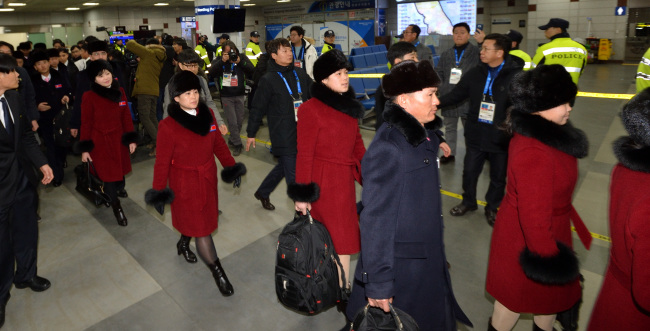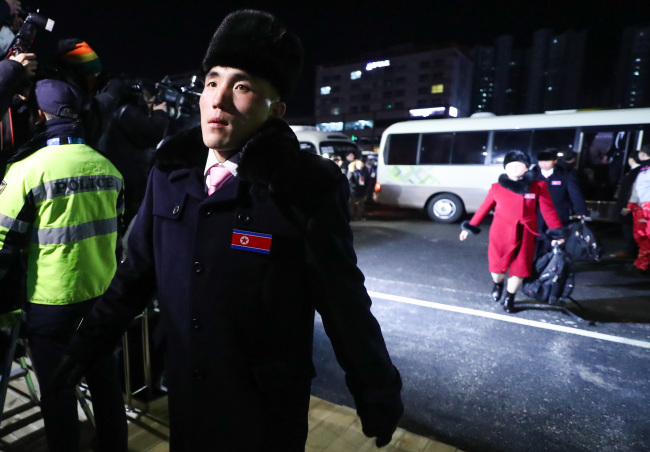Thirty-two North Koreans, including 10 athletes, landed in South Korea at around 6:09 p.m., Thursday, Seoul’s Unification Ministry confirmed, to compete in the upcoming PyeongChang Winter Olympics.
The North Koreans took off from Kalma Airport in Kangwon Province, North Korea along with the South Korean ski team that had traveled to the North on Wednesday aboard a chartered Asiana Airlines plane for a joint ski training session. The same aircraft was used to transport the group back to South Korea.
The North Korean athletes are to stay at Gangneung Olympic Village, in Gangneung, Gangwon Province. Gangneung, located only about 30 kilometers away from the host city of PyeongChang, will host ice sports during the Winter Games.
North Korean Vice Sports Minister Won Kil-u headed the North Korean delegation that includes three alpine skiers, three cross-country skiers, two figure skaters and two short track speedskaters.
 |
North Korean delegation arrives at the South Korean airport in Yangyang, Gangwon Province on Thursday. Yonhap |
Upon setting foot in South Korea, Won told local press, “I send regards from our people of the North to the people in the South.”
Won and the rest of the North Korean delegation maintained a stoic and reserved attitude before departing on a bus to Gangneung.
Figure skating pairs duo Ryom Tae-ok and Kim Ju-sik were also spotted at Yangyang International Airport in Gangwon, where the plane landed. The duo clinched the bronze medal at the International Skating Union Four Continents Figure Skating Championships in Taiwan last weekend, which is apparently North Korea‘s first medal at an ISU-sanctioned event.
Twelve North Korean hockey players had already begun practicing with their South Korean teammates on the unified inter-Korean women’s team. The hockey players crossed the border last week via Kaesong, on the western land route.
The unified team is slated to play Sweden in a pre-Olympic tuneup match at 6 p.m. Sunday in Incheon.
Reopening of inter-Korean air route
An inter-Korean air route was last used in October 2015 for a soccer friendly in Pyongyang. At the time, South Koreans boarded a plane at Gimpo Airport and flew to Sunan International Airport in Pyongyang.
Inter-Korean communication between air traffic control towers was also revived with Wednesday’s flight, according to the Ministry of Land, Infrastructure, and Transport. To support the flight, an air traffic control tower in Daegu, North Gyeongsang Province, exchanged necessary information such as call signs, flight altitude and expected arrival time with its Pyongyang counterpart.
 |
North Korean athletes arrive at the atheletes' village in Gangneung, Gangwon Province on Thursday. (Yonhap) |
A government official said the inter-Korean cooperation to restore air traffic communication had started some time before Wednesday’s flight, with exchanges of brief signals each morning at 7 a.m. Although the official did not elaborate on when, both sides had also started exchanging information on weather conditions and observations.
The control tower at Incheon Airport previously handled such tasks with the North until its backup in Daegu started operations last year.
But experts are skeptical that the route will become “permanent” amid the US-led pressure campaign against North Korea. Washington has agreed to support inter-Korean cooperation for the Winter Games, but it is uncertain whether the stance will continue after the Olympics.
“The latest flight to North Korea was greenlighted by the US because it was transporting athletes and Masikryong Ski Resort was nearby Kalma Airport,” Cha Du-hyeogn, a visiting research fellow at the Asan Institute for Policy Studies told The Korea Herald.
“It would be very dangerous to regularize inter-Korean air routes because it goes against the basic spirit of the existing sanctions against the North,” he added.
Wednesday’s flight also drew concerns here, as the US approved the trip at the last minute before the flight took off. There were concerns from the US and Asiana Airlines regarding a possible sanctions violation, but the issues were resolved, Seoul’s Unification Ministry spokesperson Baik Tae-hyun said at a press briefing.
US unilateral sanctions announced in 2017 against North Korea state that no vessel or aircraft can visit the US within 180 days of going to North Korea. But Washington made a special exemption for the flight.
Aside from the risk of sanctions violations, using the air route entails military complications and risks as well. The Asiana Airlines aircraft avoided flying directly over the military demarcation line, a de facto border separating the two Koreas, opting for a route over the East Sea.
The South’s Ministry of Land, Infrastructure and Transport said Thursday that the East Sea air route was drawn for temporary use.
There is also an agreed “no-fly” zone near the military demarcation line that extends to a maritime region in the East Sea. Both Koreas are extremely sensitive about aircraft and drones entering the zone.
The divided Koreas technically remain at war since the end of the 1950-1953 Korean War ending in a cease-fire, not a treaty.
Seoul has hinted it used the air route instead of a land route out of convenience. Masikryong Ski Resort is only a 45-minute drive from Kalma Airport, the military airfield used for this week’s round trip.
Cross-border land routes in both the eastern and western parts of the South are expected to be more frequently used. Last week, North Korea sent its 12 ice hockey players via the western land route, and previously an advance team came via the eastern route.
South Korea is hoping that the PyeongChang Olympics pave the way for improved inter-Korean relations and bring North Korea to denuclearization dialogue.
By Jung Min-kyung & Joint Press Corps (
mkjung@heraldcorp.com)


![[PyeongChang 2018] Athletes' villages in PyeongChang, Gangneung officially open](http://res.heraldm.com/phpwas/restmb_idxmake.php?idx=605&simg=/content/image/2018/02/01/20180201000681_0.jpg)
![[PyeongChang 2018] Seoul announces measures to support foreign visitors to Olympics](http://res.heraldm.com/phpwas/restmb_idxmake.php?idx=605&simg=/content/image/2018/02/01/20180201000911_0.jpg)
![[PyeongChang 2018] Korea to deploy 13,000 trash cans made of recycled paper at Olympics](http://res.heraldm.com/phpwas/restmb_idxmake.php?idx=605&simg=/content/image/2018/02/01/20180201000936_0.jpg)







